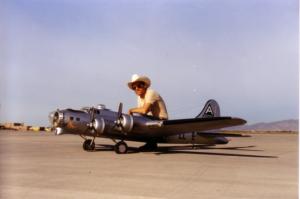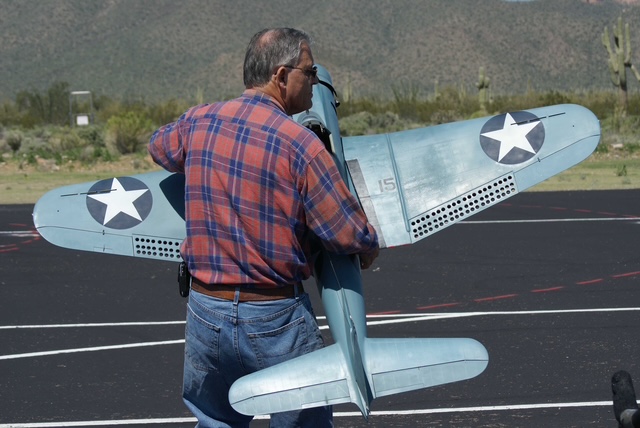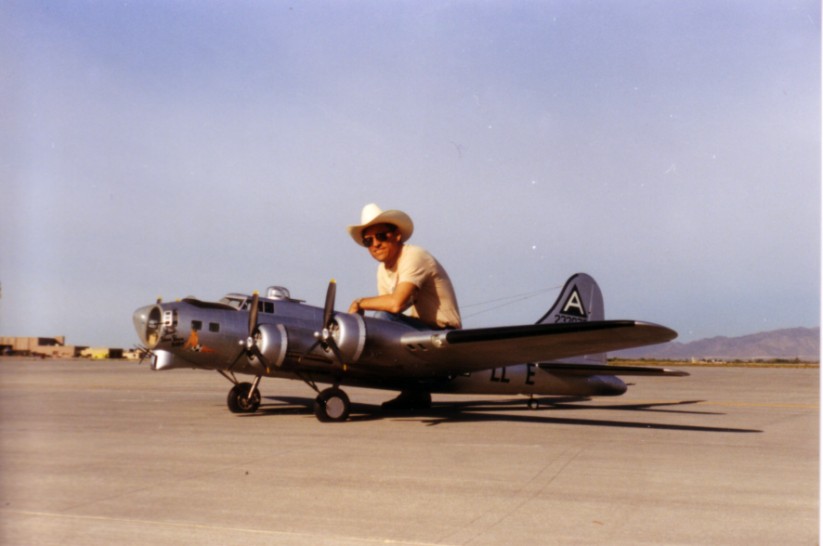
Like many older scale modelers, flying such models began in Control Line well before RC was commercially available with added control features for overall flight realism. In my case, that was in the early 1950s with small models using 0.049 engines. I then progressed to larger sizes when I traded 4 new 0.049 engines (that I won as a delivery boy for the Phoenix Gazette newspaper) for a larger McCoy redhead 0.29 engine at Webster’s Hobby Shop in Phoenix. I placed that on the front of an AT6 that I built in 1954-55 with an approximate 40-inch wingspan, as I recall. I flew it successfully for quite some time on control lines before retiring it.
I then built a larger 72-inch Sterling kit Piper Cub Super Cruiser in 1960 for CL before entering college. It hung from the ceiling until 1970 before flying it after graduating from Arizona State University (ASU) with a Masters degree (MSEE). During my time at ASU, I worked my way through school with an interesting job with KPHO-TV in Phoenix as studio assistant, film editor, and engineer. That was followed up later with Motorola as a semiconductor engineer after my initial graduation with a bachelor’s degree in 1965-66.
After graduating with a Master's degree in 1969, I wanted to find a hobby that I could be active in. It quickly became evident that RC equipment had evolved with reliable proportional control features with much more realism offered for flying beyond what I had experienced in Control Line. At that time in 1971, I purchased a GD-19 Heathkit radio system for converting the earlier built Piper Cub Super Cruiser to RC where I also received help in learning how to fly at one of our informal flying sites in north Phoenix. That flying site, along with others used during the 1970s in north Phoenix, were simply called “dust bowls” and have long since been grown over with shopping malls and houses.
I started competing in RC Scale in 1973-74 with a Top Flite P-40 that was quickly followed with a Royal “60 size” Corsair and then eventually with a somewhat larger SBD-3 Douglas Dauntless with a “Complete-A Pak” kit from Bob Holman in 1975-76. The initial scale contests were far out on the west side of Phoenix at an abandoned “Luke Aux 2” flying site since it had a resurfaced section of runway for that purpose. In 1975-76, many of the local scale modelers in Phoenix wanted to start a scale organization when I also offered a proposed name of the “One Eighth Air Force.” They quickly adopted the name where it continued to be very active for many years with members from all over the USA and other countries.

During this same time, I also helped start a nonprofit organization to help acquire model flying sites identified as the Central Arizona Modelers Advisory Council (CAMAC). It also became one of the early AMA Chapters where I served as president for almost 40 years. With that activity starting in the 1980s, clubs in Phoenix were fortunate to start obtaining formal leases with government agencies for RC flying sites. With each flying site acquisition, it did not take long to generate paved runways, covered pit areas, as well as improved roadway and parking areas that were mostly provided or paid for by host club members. In retrospect, one of the most important contact letters for our early flying sites in Arizona was with senator Barry Goldwater, who had well-known interests in aviation. One letter he wrote back to me describing his assistance indicated he also wanted to fly RC helicopters.
During that same time frame, starting in 1980, the US Scale Masters began with the efforts of Harris Lee and the "Scale Squadron" in California. That club had also begun in the mid-1970s, just prior to the One Eighth Air Force, as I recall. I was fortunate to win the first US Scale Masters in 1980 with my SBD-3 Douglas Dauntless and followed up again in 1982 and 1985. I then served as chief judge in the US Scale Masters program for their Championship events starting in 1990. That continued to 1997, when I returned to competition in 1998 with a larger scratch-built SBD-3 and managed to again win the US Scale Masters Championship in 2002, along with high placements in other years until 2005. At the 2004 Championship near Kansas City, I placed 2nd where a very good model photographer, Ben Lanterman, took a well-timed photo of my Dauntless during one of the dive-bomb maneuvers I had been doing for many years. It made its way to the internet and eventually was used on the front cover of a book on the Battle of Midway, as shown in the following web link: https://www.amazon.com/No-Right-Win-Continuing-Dialogue/dp/0595405118.
I also served as the AMA District 10 AMA Scale Contest Board member for 25 years until the end of 2023. Before and during that time as an SCB member, I continued submitting many scale proposals to the AMA, mostly in the 1993 to 2003 period, using the same improvements implemented into the USSMA program where they were all accepted into AMA Scale rules. This included additional flight maneuver options and descriptions as well as a better definition of optimum speed rather than rely only on what was previously a controversial ‘scale speed’ description. That had also become a notable issue in many magazine articles in the 1980s and 1990s, since it was contradictory to many other recognized forms of flight realism and overall flight physics as documented by NASA and others in prototype model design evaluations. A detailed summary of that topic for overall maneuver realism is still available online at: Maneuver Realism Speed.
Other models I built and flew in the 1979-1984 period included a large B-17G in 1/8 scale with a 13-foot wingspan, including all the panel lines and rivets. After 5,000 hours of building and marking with documentation from the full-size restoration project at Dover AFB, I discovered the last pilot (Robert J. Guenther) that flew this specific B-17 into combat during 1944 lived 3 blocks from me in Scottsdale! He visited and also came to one of our One Eighth Air Force Scale Fly-Ins.

With further research, I was also fortunate to talk to the pilot (George H. Goldsmith) of the SBD-3 I had modeled several times since 1975, before he passed away in 1990. He flew this well documented SBD-3 into the Battle of Midway from the USS Enterprise on June 4, 1942, and added further interesting background to the photos I used in my scale documentation including his return landing on the Yorktown where he described it as "the first friendly dry place he could land before running out of gas." I also talked to Richard Best and exchanged letters for further color documentation before he passed away in 2000. He was the important commander of Bombing Group 6 who led this particular group of Dauntless aircraft into battle from the USS Enterprise. I believe he was the last surviving commander from the Battle of Midway. As history books now indicate, the Battle of Midway became the recognized turning point in the battle for the Pacific.
In summary, our Scale RC hobby has been very rewarding in meeting many good people in our hobby, as well as important people in our aviation history.


